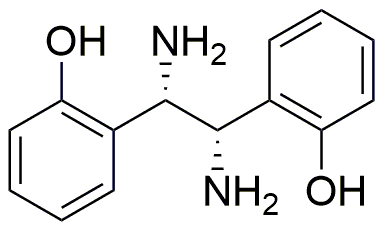(1S,2S)-1,2-Bis(2-hydroxyphenyl)ethylenediamine is widely utilized in research focused on:
- Pharmaceutical Development: This compound serves as a key intermediate in the synthesis of various pharmaceuticals, particularly in the development of drugs targeting neurological disorders.
- Chemical Synthesis: It is used as a ligand in coordination chemistry, facilitating the formation of metal complexes that are essential for catalysis in organic reactions.
- Analytical Chemistry: The compound acts as a reagent in analytical methods, enhancing the detection of specific analytes in complex mixtures, which is crucial in quality control processes.
- Biochemical Research: It plays a role in studying enzyme interactions and mechanisms, providing insights into biochemical pathways that can lead to new therapeutic targets.
- Material Science: This chemical is explored for its potential in developing advanced materials, such as polymers with enhanced thermal and mechanical properties, benefiting industries like aerospace and automotive.
General Information
Properties
Safety and Regulations
Applications
(1S,2S)-1,2-Bis(2-hydroxyphenyl)ethylenediamine is widely utilized in research focused on:
- Pharmaceutical Development: This compound serves as a key intermediate in the synthesis of various pharmaceuticals, particularly in the development of drugs targeting neurological disorders.
- Chemical Synthesis: It is used as a ligand in coordination chemistry, facilitating the formation of metal complexes that are essential for catalysis in organic reactions.
- Analytical Chemistry: The compound acts as a reagent in analytical methods, enhancing the detection of specific analytes in complex mixtures, which is crucial in quality control processes.
- Biochemical Research: It plays a role in studying enzyme interactions and mechanisms, providing insights into biochemical pathways that can lead to new therapeutic targets.
- Material Science: This chemical is explored for its potential in developing advanced materials, such as polymers with enhanced thermal and mechanical properties, benefiting industries like aerospace and automotive.
Documents
Safety Data Sheets (SDS)
The SDS provides comprehensive safety information on handling, storage, and disposal of the product.
Product Specification (PS)
The PS provides a comprehensive breakdown of the product’s properties, including chemical composition, physical state, purity, and storage requirements. It also details acceptable quality ranges and the product's intended applications.
Certificates of Analysis (COA)
Search for Certificates of Analysis (COA) by entering the products Lot Number. Lot and Batch Numbers can be found on a product’s label following the words ‘Lot’ or ‘Batch’.
*Catalog Number
*Lot Number
Certificates Of Origin (COO)
This COO confirms the country where the product was manufactured, and also details the materials and components used in it and whether it is derived from natural, synthetic, or other specific sources. This certificate may be required for customs, trade, and regulatory compliance.
*Catalog Number
*Lot Number
Safety Data Sheets (SDS)
The SDS provides comprehensive safety information on handling, storage, and disposal of the product.
DownloadProduct Specification (PS)
The PS provides a comprehensive breakdown of the product’s properties, including chemical composition, physical state, purity, and storage requirements. It also details acceptable quality ranges and the product's intended applications.
DownloadCertificates of Analysis (COA)
Search for Certificates of Analysis (COA) by entering the products Lot Number. Lot and Batch Numbers can be found on a product’s label following the words ‘Lot’ or ‘Batch’.
*Catalog Number
*Lot Number
Certificates Of Origin (COO)
This COO confirms the country where the product was manufactured, and also details the materials and components used in it and whether it is derived from natural, synthetic, or other specific sources. This certificate may be required for customs, trade, and regulatory compliance.


